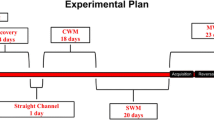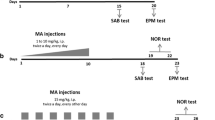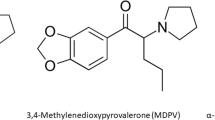Abstract
Rationale
Considerable evidence indicates that amphetamine derivatives can deplete brain monoaminergic neurotransmitters. However, the behavioral and cognitive consequences of neurochemical depletions induced by amphetamines are not well established.
Objectives
In this study, mice were exposed to dosing regimens of 3,4-methylenedioxymethamphetamine (MDMA), methamphetamine (METH), or parachloroamphetamine (PCA) known to deplete the monoamine neurotransmitters dopamine and serotonin, and the effects of these dosing regimens on learning and memory were assessed.
Methods
In the same animals, we determined deficits in learning and memory via passive avoidance (PA) behavior and changes in tissue content of monoamine neurotransmitters and their primary metabolites in the striatum, frontal cortex, cingulate, hippocampus, and amygdala via ex vivo high-pressure liquid chromatography.
Results
Exposure to METH and PCA impaired PA performance and resulted in significant depletions of dopamine, serotonin, and their metabolites in several brain regions. Multiple linear regression analysis revealed that the tissue concentration of dopamine in the anterior striatum was the strongest predictor of PA performance, with an additional significant contribution by the tissue concentration of the serotonin metabolite 5-hydroxyindoleacetic acid in the cingulate. In contrast to the effects of METH and PCA, exposure to MDMA did not deplete anterior striatal dopamine levels or cingulate levels of 5-hydroxyindoleacetic acid, and it did not impair PA performance.
Conclusions
These studies demonstrate that certain amphetamines impair PA performance in mice and that these impairments may be attributable to specific neurochemical depletions.




Similar content being viewed by others
References
Achat-Mendes C, Ali SF, Itzhak Y (2005) Differential effects of amphetamines-induced neurotoxicity on appetitive and aversive Pavlovian conditioning in mice. Neuropsychopharmacology 30:1128–1137
Achat-Mendes C, Anderson KL, Itzhak Y (2007) Impairment in consolidation of learned place preference following dopaminergic neurotoxicity in mice is ameliorated by N-acetylcysteine but not D1 and D2 dopamine receptor agonists. Neuropsychopharmacology 32:531–541
Adriani W, Felici A, Sargolini F, Roullet P, Usiello A, Oliverio A, Mele A (1998) N-methyl-d-aspartate and dopamine receptor involvement in the modulation of locomotor activity and memory processes. Exp Brain Res 123:52–59
Ali SF, Newport GD, Holson RR, Slikker W Jr, Bowyer JF (1994) Low environmental temperatures or pharmacologic agents that produce hypothermia decrease methamphetamine neurotoxicity in mice. Brain Res 658:33–38
Barrionuevo M, Aguirre N, Del Rio JD, Lasheras B (2000) Serotonergic deficits and impaired passive-avoidance learning in rats by MDEA: a comparison with MDMA. Pharmacol Biochem Behav 65:233–240
Belcher AM, Feinstein EM, O’Dell SJ, Marshall JF (2008) Methamphetamine influences on recognition memory: comparison of escalating and single-day dosing regimens. Neuropsychopharmacology 33:1453–1463
Bolla KI, McCann UD, Ricaurte GA (1998) Memory impairment in abstinent MDMA (“Ecstasy”) users. Neurology 51:1532–1537
Buchert R, Obrocki J, Thomasius R, Vaterlein O, Petersen K, Jenicke L, Bohuslavizki KH, Clausen M (2001) Long-term effects of ‘ecstasy’ abuse on the human brain studied by FDG PET. Nucl Med Commun 22:889–897
Colado MI, O’Shea E, Green AR (2004) Acute and long-term effects of MDMA on cerebral dopamine biochemistry and function. Psychopharmacology (Berl) 173:249–263
Fantegrossi WE, Ciullo JR, Wakabayashi KT, De La Garza R 2nd, Traynor JR, Woods JH (2008) A comparison of the physiological, behavioral, neurochemical and microglial effects of methamphetamine and 3,4-methylenedioxymethamphetamine in the mouse. Neuroscience 151:533–543
Fuller RW, Hines CW, Mills J (1965) Lowering of brain serotonin level by chloramphetamines. Biochem Pharmacol 14:483–488
Fuller RW, Baker JC, Molloy BB (1977) Biological disposition of rigid analogs of amphetamine. J Pharm Sci 66:271–272
Gibb JW, Johnson M, Stone D, Hanson GR (1990) MDMA: historical perspectives. Ann N Y Acad Sci 600:601–611, discussion 611–2
Gower AJ, Lamberty Y (1993) The aged mouse as a model of cognitive decline with special emphasis on studies in NMRI mice. Behav Brain Res 57:163–173
Hanson KL, Luciana M (2004) Neurocognitive function in users of MDMA: the importance of clinically significant patterns of use. Psychol Med 34:229–246
Hirata H, Ladenheim B, Rothman RB, Epstein C, Cadet JL (1995) Methamphetamine-induced serotonin neurotoxicity is mediated by superoxide radicals. Brain Res 677:345–347
Itzhak Y, Achat-Mendes CN, Ali SF, Anderson KL (2004) Long-lasting behavioral sensitization to psychostimulants following p-chloroamphetamine-induced neurotoxicity in mice. Neuropharmacology 46:74–84
Kalechstein AD, Newton TF, Green M (2003) Methamphetamine dependence is associated with neurocognitive impairment in the initial phases of abstinence. J Neuropsychiatry Clin Neurosci 15:215–220
Kalechstein AD, De La Garza R 2nd, Mahoney JJ 3rd, Fantegrossi WE, Newton TF (2007) MDMA use and neurocognition: a meta-analytic review. Psychopharmacology (Berl) 189:531–537
Kish SJ, Furukawa Y, Ang L, Vorce SP, Kalasinsky KS (2000) Striatal serotonin is depleted in brain of a human MDMA (Ecstasy) user. Neurology 55:294–296
Kita T, Wagner GC, Nakashima T (2003) Current research on methamphetamine-induced neurotoxicity: animal models of monoamine disruption. J Pharmacol Sci 92:178–195
Krasnova IN, Hodges AB, Ladenheim B, Rhoades R, Phillip CG, Cesena A, Ivanova E, Hohmann CF, Cadet JL (2009) Methamphetamine treatment causes delayed decrease in novelty-induced locomotor activity in mice. Neurosci Res 65:160–165
McCann UD, Szabo Z, Scheffel U, Dannals RF, Ricaurte GA (1998) Positron emission tomographic evidence of toxic effect of MDMA (“Ecstasy”) on brain serotonin neurons in human beings. Lancet 352:1433–1437
McCann UD, Peterson SC, Ricaurte GA (2007) The effect of catecholamine depletion by alpha-methyl-para-tyrosine on measures of cognitive performance and sleep in abstinent MDMA users. Neuropsychopharmacology 32:1695–1706
McCardle K, Luebbers S, Carter JD, Croft RJ, Stough C (2004) Chronic MDMA (ecstasy) use, cognition and mood. Psychopharmacology (Berl) 173:434–439
Miller DB, O’Callaghan JP (1995) The role of temperature, stress, and other factors in the neurotoxicity of the substituted amphetamines 3,4-methylenedioxymethamphetamine and fenfluramine. Mol Neurobiol 11:177–192
Myhrer T (2003) Neurotransmitter systems involved in learning and memory in the rat: a meta-analysis based on studies of four behavioral tasks. Brain Res Brain Res Rev 41:268–287
O’Callaghan JP, Miller DB (1994) Neurotoxicity profiles of substituted amphetamines in the C57BL/6J mouse. J Pharmacol Exp Ther 270:741–751
Obrocki J, Schmoldt A, Buchert R, Andresen B, Petersen K, Thomasius R (2002) Specific neurotoxicity of chronic use of ecstasy. Toxicol Lett 127:285–297
Paxinos G, Franklin KBJ (2001) The mouse brain in stereotaxic coordinates, 2nd edn. Academic Press, San Diego
Pletscher A, Burkard WP, Bruderer H, Gey KF (1963) Decrease of cerebral 5-hydroxytryptamine and 5-hydroxyindolacetic acid by an arylalkylamine. Life Sci 11:828–833
Pletscher A, Bartholini G, Bruderer H, Burkard WP, Gey KF (1964) Chlorinated arylalkylamines affecting the cerebral metabolism of 5-hydroxytryptamine. J Pharmacol Exp Ther 145:344–350
Reneman L, Booij J, de Bruin K, Reitsma JB, de Wolff FA, Gunning WB, den Heeten GJ, van den Brink W (2001) Effects of dose, sex, and long-term abstention from use on toxic effects of MDMA (ecstasy) on brain serotonin neurons. Lancet 358:1864–1869
Renoir T, Paizanis E, Yacoubi ME, Saurini F, Hanoun N, Melfort M, Lesch KP, Hamon M, Lanfumey L (2008) Differential long-term effects of MDMA on the serotoninergic system and hippocampal cell proliferation in 5-HTT knock-out vs. wild-type mice. Int J Neuropsychopharmacol 11:1149–1162
Ricaurte GA (1989) Studies of MDMA-induced neurotoxicity in nonhuman primates: a basis for evaluating long-term effects in humans. NIDA Res Monogr 94:306–322
Saadat KS, Elliott JM, Colado MI, Green AR (2006a) The acute and long-term neurotoxic effects of MDMA on marble burying behaviour in mice. J Psychopharmacol 20:264–271
Saadat KS, Elliott JM, Green AR, Moran PM (2006b) High-dose MDMA does not result in long-term changes in impulsivity in the rat. Psychopharmacology (Berl) 188:75–83
Sanders-Bush E, Bushing JA, Sulser F (1975) Long-term effects of p-chloroamphetamine and related drugs on central serotonergic mechanisms. J Pharmacol Exp Ther 192:33–41
Santucci AC, Knott PJ, Haroutunian V (1996) Excessive serotonin release, not depletion, leads to memory impairments in rats. Eur J Pharmacol 295:7–17
Schmidt CJ, Levin JA, Lovenberg W (1987) In vitro and in vivo neurochemical effects of methylenedioxymethamphetamine on striatal monoaminergic systems in the rat brain. Biochem Pharmacol 36:747–755
Scott JC, Woods SP, Matt GE, Meyer RA, Heaton RK, Atkinson JH, Grant I (2007) Neurocognitive effects of methamphetamine: a critical review and meta-analysis. Neuropsychol Rev 17:275–297
Simon SL, Dean AC, Cordova X, Monterosso JR, London ED (2010) Methamphetamine dependence and neuropsychological functioning: evaluating change during early abstinence. J Stud Alcohol Drugs 71:335–344
Steranka LR, Sanders-Bush E (1980) Long-term effects of continuous exposure to amphetamine on brain dopamine concentration and synaptosomal uptake in mice. Eur J Pharmacol 65:439–443
Steranka L, Bessent R, Sanders-Bush E (1977) Reversible and irreversible effects of p-chloroamphetamine on brain serotonin in mice. Commun Psychopharmacol 1:447–454
Stone DM, Hanson GR, Gibb JW (1987) Differences in the central serotonergic effects of methylenedioxymethamphetamine (MDMA) in mice and rats. Neuropharmacology 26:1657–1661
Sugimoto Y, Ohkura M, Inoue K, Yamada J (2001) Involvement of serotonergic and dopaminergic mechanisms in hyperthermia induced by a serotonin-releasing drug, p-chloroamphetamine in mice. Eur J Pharmacol 430:265–268
Taghzouti K, Simon H, Louilot A, Herman JP, Le Moal M (1985) Behavioral study after local injection of 6-hydroxydopamine into the nucleus accumbens in the rat. Brain Res 344:9–20
Timar J, Gyarmati S, Szabo A, Furst S (2003) Behavioural changes in rats treated with a neurotoxic dose regimen of dextrorotatory amphetamine derivatives. Behav Pharmacol 14:199–206
Wang X, Baumann MH, Xu H, Rothman RB (2004) 3,4-Methylenedioxymethamphetamine (MDMA) administration to rats decreases brain tissue serotonin but not serotonin transporter protein and glial fibrillary acidic protein. Synapse 53:240–248
Wilson JM, Kalasinsky KS, Levey AI, Bergeron C, Reiber G, Anthony RM, Schmunk GA, Shannak K, Haycock JW, Kish SJ (1996) Striatal dopamine nerve terminal markers in human, chronic methamphetamine users. Nat Med 2:699–703
Winsauer PJ, McCann UD, Yuan J, Delatte MS, Stevenson MW, Ricaurte GA, Moerschbaecher JM (2002) Effects of fenfluramine, m-CPP and triazolam on repeated-acquisition in squirrel monkeys before and after neurotoxic MDMA administration. Psychopharmacology (Berl) 159:388–396
Author information
Authors and Affiliations
Corresponding author
Additional information
All authors have no conflicts of interest regarding this work. These studies were funded by the National Institutes of Health [DA024760 (SAP), DA 16736 (MPG), DA000517 (LLH), DA020645 (WEF)] and by the Yerkes Base Grant [RR00165 (KSM; LLH; WEF)]. Preliminary findings from these experiments were previously presented at the 2009 scientific meetings of the College on Drug Dependence in Reno, NV, USA by KSM and the Society for Neuroscience in Chicago, IL, USA by SAP.
Electronic supplementary material
Below is the link to the electronic supplementary material.
Supplementary Figure 1
(DOC 161 kb)
Rights and permissions
About this article
Cite this article
Murnane, K.S., Perrine, S.A., Finton, B.J. et al. Effects of exposure to amphetamine derivatives on passive avoidance performance and the central levels of monoamines and their metabolites in mice: Correlations between behavior and neurochemistry. Psychopharmacology 220, 495–508 (2012). https://doi.org/10.1007/s00213-011-2504-0
Received:
Accepted:
Published:
Issue Date:
DOI: https://doi.org/10.1007/s00213-011-2504-0




